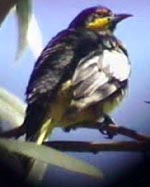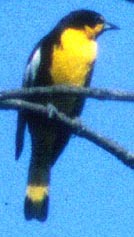 on:
on:
Black-backed Oriole Icterus abeillei
Smuggler's Gulch, Tijuana River Valley, Imperial Beach
San Diego County, California
25 June 2000
Joseph Morlan

 Today, Robbie Fischer and I decided to try
for the Black-backed Oriole which has been present at Smuggler's Gulch since 9 April 2000 when it was first discovered
and photographed by Gjon Hazard, John Hunter and David Solis. We arrived around 7am but did not see the oriole
until about 8:30 when Guy McCaskie spotted it in a dead snag high in a eucalyptus at the abandoned Windover Ranch.
At this time, most observers got poor views of the bird before it disappeared in the direction of Monument Road.
Today, Robbie Fischer and I decided to try
for the Black-backed Oriole which has been present at Smuggler's Gulch since 9 April 2000 when it was first discovered
and photographed by Gjon Hazard, John Hunter and David Solis. We arrived around 7am but did not see the oriole
until about 8:30 when Guy McCaskie spotted it in a dead snag high in a eucalyptus at the abandoned Windover Ranch.
At this time, most observers got poor views of the bird before it disappeared in the direction of Monument Road.
Guy and I headed toward the road and soon located the adult male Black-backed Oriole across the street. It sat in the open on a wire and then moved into a low shrub close to the road where we had outstanding views. We notified the others by radio, but by the time they arrived, the bird had flown to a large eucalyptus on the back side of the buildings. It then flew again into some tree tobacco between two lines of tamarisk growing on a levee leading north from the road. Here we managed to get the bird into Guy's telescope and most people were able to get reasonable, if distant views. Finally it flew back in the direction of Smuggler's Gulch as it started to rain and we gave up chasing it any further.
The following is based on notes taken immediately after the observati on:
on:
A rather dark oriole, similar to nearby Bullock's Orioles, but much darker on the face and back. The entire face, nape and back was solid black. The black auriculars were bordered by a dark orange malar stripe on either side of the black throat, connecting to the dark orange on the side of the breast. A black bib, similar to that of Bullock's Oriole was evident and a small spot of dark orange showed in the lore area.
The underparts were orange, darker and slightly browner than the orange on male Bullock's Orioles. The coloration of the Black-backed Oriole thus recalled that of Black-headed Grosbeak. The lower breast and belly were a lighter yellow color, contrasting with extensive black on the sides and flanks. The wings were patterned identically to that of adult male Bullock's Orioles, showing a large white wing panel on the greater coverts and conspicuous white fringes on the tertials and secondaries.
The bird fanned its tail while sitting in the shrub, displaying a black tail, with bold rectangular yellow patches on the basal 3/4 of the outer rectrices. The tip of the tail was black. The bill and legs were black. The bill was thin and pointed, slightly curved, similar in shape to Bullock's Oriole but not as curved as in Hooded Orioles, several of which were also in the area.
The bird gave a typical oriole chatter, indistinguishable from that of Bullock's Oriole, but we did not hear it sing. Many of the adult male Bullock's were singing, however.
Discussion
There is no question about this bird's identity. The questions revolve around the issue of natural occurrence vs. the possibility of it being and escaped captive. These issues have been publicly discussed by McCaskie and others. Although this bird was originally dismissed as an "obvious" escape, it now seems that its status is not quite so obvious. Most observers seem to agree that there is a genuine possibility that this bird is a naturally occurring stray.
Others seeing the bird this morning included Betty Siegel (who saw it early in the morning in eucalyptus at the intersection of Hollister and Monument), Guy McCaskie, Therese Clawson, Dean Vanier and others. All agreed with the identification. Also, this bird was not the apparent hybrid described from the area earlier in the season.
An additional account with superb color sketches by Andy Birch have been posted here.